The Earth’s core is not just made of iron and nickel, but also contains rare impurities that alter its density. These impurities, including uranium and thorium, contribute to the high temperatures deep within the Earth.
For a long time, the quantity of these impurities, as well as precious metals, remained a mystery. However, in 2006, a team of scientists found a way to estimate their abundance. They studied certain asteroids that have a similar composition to the Earth and calculated the amount of each element present on our planet.
Although there are some assumptions and complications due to differences in the evolution of the Earth and smaller objects, the team led by Professor Bernard Wood of Macquarie University managed to create a model that partially verified their findings. They discovered that elements that do not dissolve in liquid iron are more abundant in the Earth’s crust than expected, suggesting that the planet is not homogenous.
Wood and his colleagues also found that these elements have the same abundance in the Earth’s crust as in the meteorites they studied, confirming that both formed from the same material. However, the meteorites contain higher concentrations of elements that dissolve in iron, which were incorporated into the Earth’s core when it formed.
Based on their research, Wood and his co-authors estimated that more than 99% of the Earth’s gold is located in the core. This information is not only fascinating but also has implications for space exploration. Surviving asteroids, especially those believed to represent the cores of planetesimals, are likely to contain large quantities of these valuable elements.
While reports of the upcoming Psyche mission often exaggerate the asteroid’s value, it is important to remember that if such a source of precious metals became available, prices would plummet. Similarly, if the gold trapped in the Earth’s core were to be released, it would lose its value. So, while it may be a nice image to imagine being knee-deep in gold, it wouldn’t actually matter.
Wood’s groundbreaking studies were published in Earth and Planetary Sciences and Nature in 2005 and 2006, respectively. These studies have withstood the test of time and continue to be cited in subsequent research.








